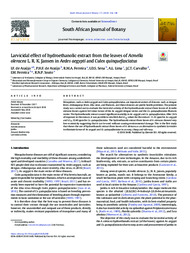Larvicidal effect of hydroethanolic extract from the leaves of Acmella oleracea L. R. K. Jansen in Aedes aegypti and Culex quinquefasciatus.
Larvicidal effect of hydroethanolic extract from the leaves of Acmella oleracea L. R. K. Jansen in Aedes aegypti and Culex quinquefasciatus.
Author(s): ARAÚJO, I. F. de; ARAÚJO, P. H. F. de; FERREIRA, R. M. A.; SENA, I. D. S.; LIMA, A. L.; CARVALHO, J. C. T.; FERREIRA, I. M.; SOUTO, R. N. P.
Summary: Mosquitoes, such as Aedes aegypti and Culex quinquefasciatus, are important vectors of diseases, such as dengue fever, chikungunya fever, Zika virus, and filariasis, and these diseases are public health problems. The present study was carried out to evaluate the larvicidal activity of the hydroethanolic extract from leaves of Acmella oleracea leaves against 3rd instar larvae of the Ae. aegypti dengue vector and the Cx. quinquefasciatus filariasis vector. The hydroethanolic extract caused significant mortality in Ae. aegypti and Cx. quinquefasciatus. After 24 h of exposure to the extract, it was possible to establish the LC50 values for the extract: 11.41 ppm for Ae. aegypti and LC50 32.40 ppm for Cx. quinquefasciatus. The hydroethanolic extract from leaves of A. oleracea showed very low ecotoxicity suggesting that it can be used without causing environmental damage. This is the first study that shows the use of hydroethanolic extract from leaves of A. oleracea as an alternative to synthetic larvicides to eliminate larvae of Ae. aegypti and Cx. quinquefasciatus in an easy, cheap and safe way.
Publication year: 2018
Types of publication: Journal article
Unit: Embrapa Amapá
Observation
Some of Embrapa's publications are published as ePub files. To read them, use or download one of the following free software options to your computer or mobile device. Android: Google Play Books; IOS: iBooks; Windows and Linux: Calibre.
Access other publications
Access the Agricultural Research Database (BDPA) to consult Embrapa's full library collection and records.
Visit Embrapa Bookstore to purchase books and other publications sold by Embrapa.

